Sid Meier's Alpha Centauri - Spartan Federation
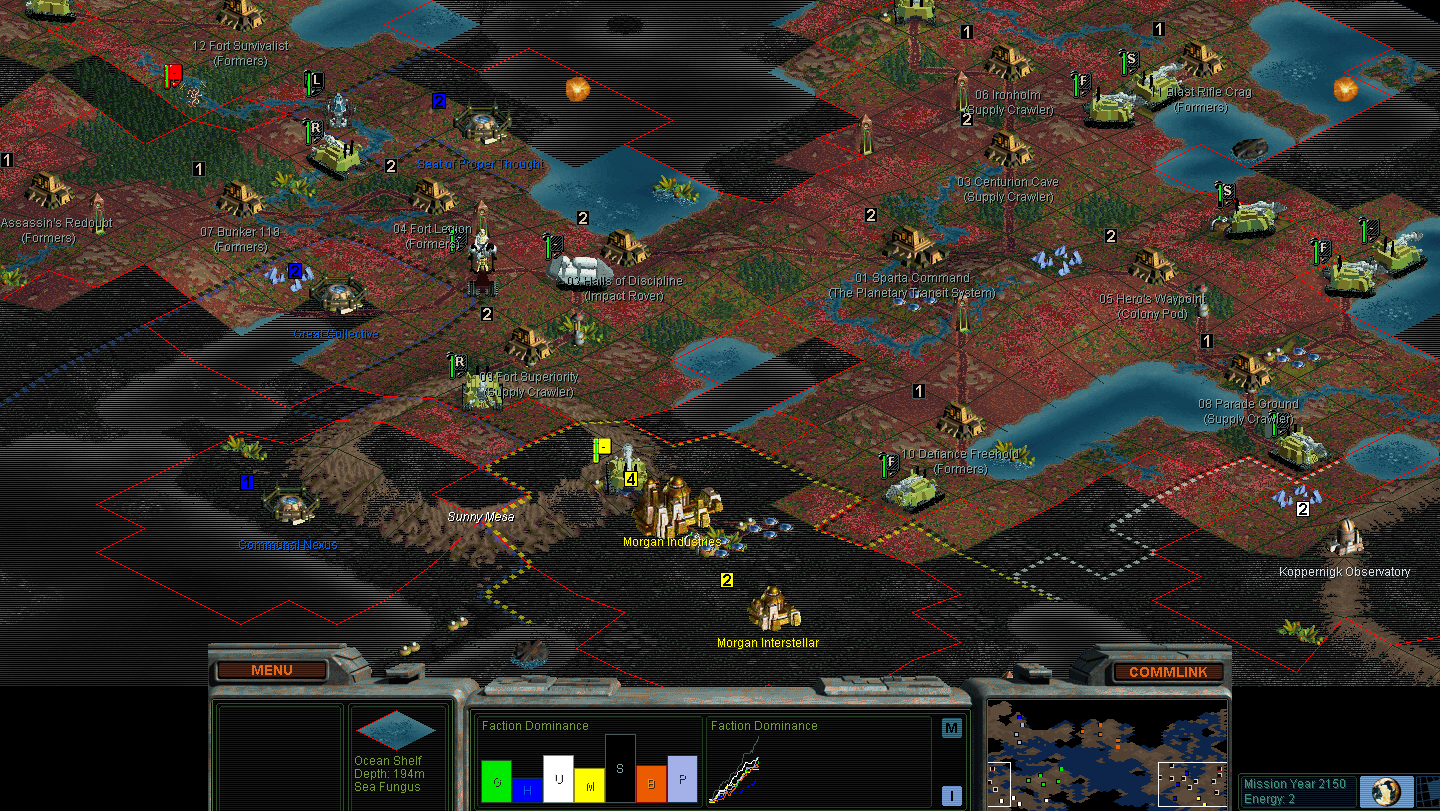
I've talked about everything except expansion, so here's an overview of that, 12 bases in year 2150. That's significantly slower by 10 to 20 turns than the best of my other games, between the industry penalty and late access to terraformers. Like I said, Sparta can do anything any other faction can, just slower. Expansion went the same as in each other game, where bases rushed colony pods as soon as practical at size 2, and built lots of formers in the intervals between colony pods.
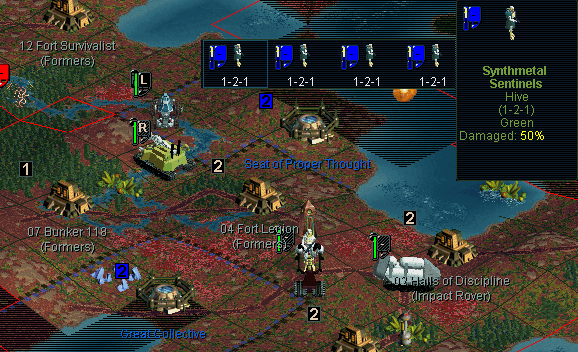
In foreign news, I'd been trying to get rid of the Hive forever but hadn't managed it. No amount of Spartan morale can get a 2-power attacker the advantage over a 2-armor defender behind the Hive's perimeter defense. I built two artillery units to fire at the Hive bases and chip down the defenders; artillery damage against units in a base is capped at 50%, but units don't heal on a turn they received artillery bombardment, so as long as I kept firing every turn the units would stay at half health. What happened over and over - five times! - was that each time my artillery got the targeted defender to half health when I'd be ready to attack with a 2-power rover, the Hive base built a new defender! So there were as many as five 1-2-1 units all at half health, but still stiff enough that I couldn't crack.
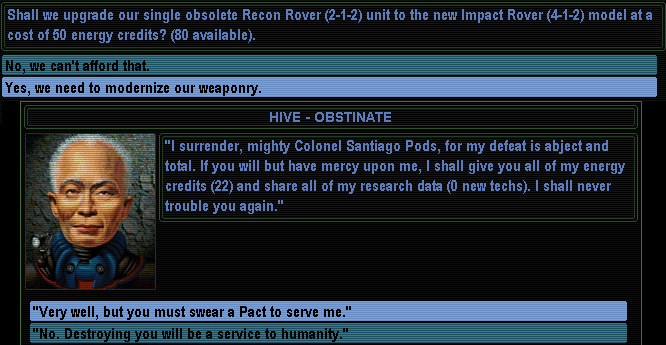
Presently the University traded me Nonlinear Mathematics, which meant I finally had impact rovers to knock off the Hive. The upgrade cost was expensive enough that I upgraded only the one rover that had reached elite morale (by killing worms and Hive formers and scouts.) I built two more fresh impact rovers as well, which now quickly cut through the still-bombarded defending units. And I took the Hive's surrender when he had one base left; it could be useful to have a voting lapdog in the Council.
As I expected, research was now lagging significantly. There really wasn't anything I could do to make any real improvement in the research rate. Most factions do that with the combination of Free Market and Wealth; but Sparta is barred from the latter, and I judged Police State to be more useful than Free Market alone. All I could do was expand horizontally and take what economy I could get from working forests and monoliths and rivers. My own blind research slowly turned up Planetary Networks then Optical Computers at time intervals of about 15 turns each.
Really the only practical way to get technology was from my rivals. The University traded me Nonlinear Mathematics, Morgan supplied Industrial Economics, the U.N. did Intellectual Integrity, and even the Believers came up with trade bait in High Energy Chemistry. In most games with directed research, I decline many trades like these for a while to prioritize targeted beelines instead. But this time with blind research I had no idea what would come when and would need everything eventually so just took whatever I could get. But here's the big one:

That message in response to a trade request means Morgan came up with Industrial Automation. I had to have that ASAP, to build crawlers and cash them into the Planetary Transit System. If he wouldn't trade it, then I'd have to take it myself with a probe. Fortunately I had the impact rovers fresh off the Hive crackdown to bring right over to deal with Morgan's vendetta too.

Morgan actually cheekily tried to resist by throwing a mind control probe at my closest base. But I easily recaptured that and continued on to Morgan Industries. Morgan then also surrendered with only one base left. He even had a tech to give me, which was Gene Splicing.
I also got a ton of cash there, 260 credits total between Morgan's HQ capture and his surrender yield. That was perfectly timed indeed - now I rushed colony pods at every size-2 base just before completing the Planetary Transit System to bounce them all back to size 3.
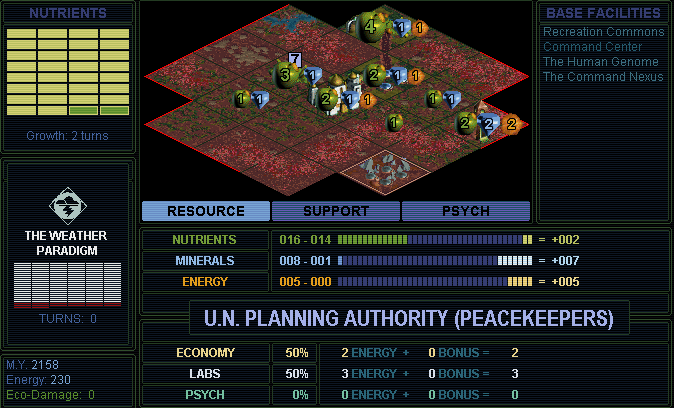
Except for this abrupt change of plans. With Morgan's surrender, I now had the votes to win the planetary governorship, so I did so. With the infiltration, I checked on the progress of enemy projects. This is mystifying on several levels. First, how the hell did this base already complete two secret projects (HGP and Command Nexus) and now also on the verge of a third?! Second, why is that project overfilled in the minerals box several rows past its full cost? Third, why is it like that mid-turn instead of completing the project on the previous turn? I don't know how this happens, although I have seen cases like this occasionally.
Anyway, the practical upshot was that I had to switch my own project to Weather Paradigm instead of the PTS on this same turn. In SMAC, a tie on completing a project always goes to the human player (unlike most of the later Civ games.) So I got the Weather Paradigm this way, while the U.N. changed their project to the Merchant Exchange, which was okay with me, that I could live without.

So then I had to do the PTS a few turns later, by the usual method of upgraded crawlers. Actually, here is one way to turn Sparta's handicap into an advantage: the industry penalty doesn't change upgrade prices, so that means upgrading crawlers gets more minerals for the same cost. Here a simple 2-armor trance model was a worthwhile enough upgrade target. That was 90 credits to upgrade a crawler from 33 minerals to 88, a difference of 55, a worthwhile price of only 1.6 credits per mineral. So after selling some techs around to raise money, I upgraded three of the five crawlers in this picture that way, and added the other two at normal value, exactly completing the PTS in one turn at 88 × 3 + 33 × 2 = 330 minerals.
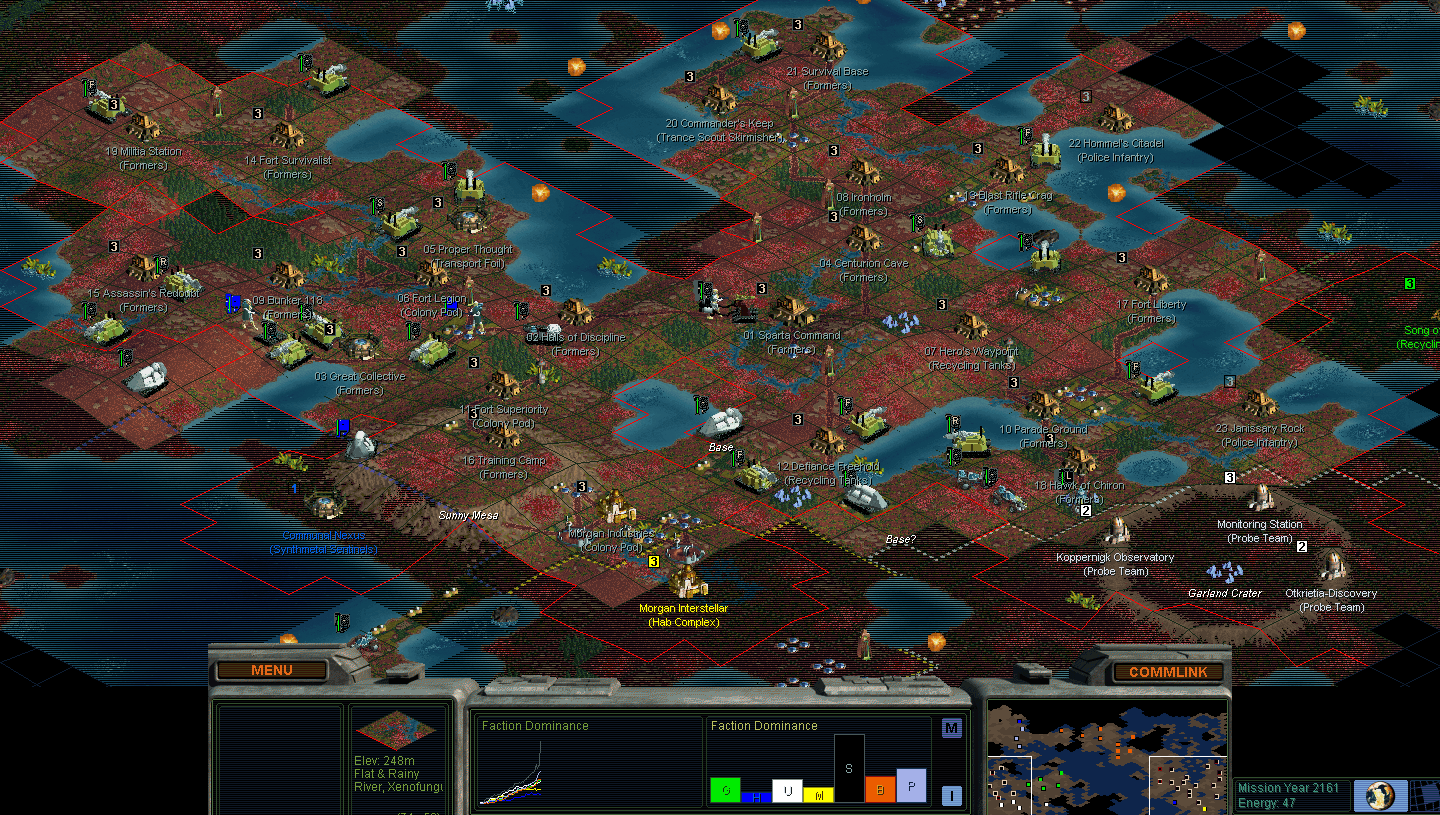
The PTS completed in year 2161, again a few tens of turns behind the other games that used it. Here's a look at everything boosted to size 3 and the resulting faction dominance graph. The downward glitch just before the surge was many bases dropping to size 1 from building a colony pod just before PTS, and so those pods were now on the move.
Next I'm going to use this space to talk about some theory.
Presently I was building lots of formers, aiming to fill the Police State support limit of 4 per base. I mostly did so, but as I neared that, it started to feel like yet more formers wouldn't pay off as well, that I wanted to get started on base facilities instead. I've had that intuition in my other games here, and then suddenly the quantitative analysis hit me.
The value of a former is not how many improvements it will build during the remaining duration of the game. It is how many turns those improvements will be worked.
This means the value of formers declines throughout the game not linearly, but exponentially. There are two factors that each decline linearly -- the number of improvements that the former will build, and the time remaining for each of those improvements to be worked. Two factors that each decline linearly, that interact multiplicatively with each other, give an overall result of quadratic decline.
Here's an illustrative numeric example. Suppose the game lasts 100 turns, and a former builds an improvement every 10 turns on average. A former at the beginning of the game will improve a tile that will be worked for 100 turns, then another that will yield for 90 turns, then 80, and so on down to 10, for a total of 600 tile-turns. A former built halfway through the game will construct an improvement to be worked for 50 turns, then 40, then 30, 20, 10, for a total of only 150 tile-turns.

Here's a graphical representation. The value of a former built at the beginning is all of the boxes. The value of a former built at the halfway point is only the shaded boxes. This shows visually how the latter only yields one-fourth the improved-tile-turns of a former that existed since the beginning!
So my intuition was correct, that formers do fall off in value rapidly. This has held true for other Civ games as well, particularly Civ 5, where it always felt like the time horizon for workers to pay off became too short quite soon. In SMAC, this explains why Adv Eco Engineering super formers haven't felt worthwhile; that tech comes with about 1/3 of the game time remaining, so a former from that point onward will contribute only 1/9 of the productivity that an early former would have, too little to be worth doubling with the super-former ability. Finally, for forests in SMAC in particular, the auto-spread is another dimension multiplicative with tile-turns, so the falloff is actually even more than quadratic. (If not for the spreading being quickly limited by available space and ineligible tiles, this falloff would actually be quartic, to the fourth power, because the auto-spread itself is quadratic too.)
Now compare formers to other build options, in particular science multiplier facilities. Like formers, the value of a multiplier building declines throughout the game in a way that is not linear. But this decay is backloaded rather than frontloaded; it is the opposite of exponential, it is a logarithmic function of the number of turns remaining, to describe the remaining labs to be processed by a multiplier.

The entire tech tree to transcendence totals roughly 100,000 labs. But 90,000 of those are backloaded into the second half of the game. A network node built at the halfway point still has 90% of the whole game's labs yet to come through it - it retains 90% of its potential early value compared to that former at 25%! So yes, the values of different types of productivity change relative to each other throughout the game.
Finally, consider a middle ground option, recycling tanks. That decline is indeed simply linear. The remaining yield yet to come from a static 1-1-1 productivity per turn is indeed a linear function of time remaining. This bears out my intuition also, that the rec-tanks are worth building sometime in the middle game, but not early against the other options of formers and colony pods. There's a little bit of a no-man's-land in the middle, when the value of a former has already sharply declined but there's no rush to build multipliers when the bulk of the baseline input is yet to come, and that's when recycling tanks plug in as the best build option.
That concludes today's lecture, and we'll move on back to the game.